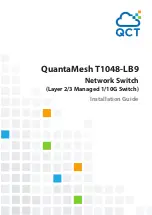
FIBER OPTIC
SFP DEVICES
An optional Gigabit SFP transceiver can be used for a
backbone connection between switches, or for
connecting to a high-speed server.
Each single-mode fiber port requires 9/125 micron
single-mode fiber optic cable with an LC connector at
both ends. Each multimode fiber optic port requires
50/125 or 62.5/125 micron multimode fiber optic cabling
with an LC connector at both ends.
W
ARNING
:
This switch uses lasers to transmit signals over fiber
optic cable. The lasers are inherently eye safe in normal
operation. However, user should never look directly at a
transmit port when it is powered on.
W
ARNING
:
When selecting a fiber SFP device, considering
safety, please make sure that it can function at a temperature
that is not less than the recommended maximum operational
temperature of the product. You must also use an approved
Laser SFP transceiver.
Step1.
Remove and keep the LC port’s rubber plug. When not connected to a fiber
cable, the rubber plug should be replaced to protect the optics.
Step2.
Check that the fiber terminators are clean. You can clean the cable plugs
by wiping them gently with a clean tissue or cotton ball moistened with a
little ethanol. Dirty fiber terminators on fiber optic cables will impair the
quality of the light transmitted through the cable and lead to degraded
performance on the port.
Step3.
Connect one end of the cable to the LC port on the switch and the other end
to the LC port on the other device. Since LC connectors are keyed, the
cable can be attached in only one orientation.
Step4.
As a connection is made, check the Link LED on the switch corresponding
to the port to be sure that the connection is valid.
The fiber optic ports operate at 1 Gbps. The maximum length for fiber optic cable
operating at Gigabit speed will depend on the fiber type as listed under “
Mbps Gigabit Ethernet Collision Domain
Revision A1
22
















































